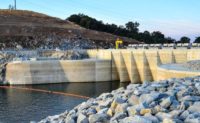“We are looking to industry to help us in formulating an acquisition strategy, to expedite delivery and provide us with a higher level of quality to help us put our best foot forward for south Louisiana,” says Jim Barr, chief of the New Orleans District’s contracting division. He spoke at an Industry Day gathering in Metairie, La., on Aug. 6. It was convened for the purpose of getting project information out and soliciting ideas back. “We are looking for the standard answers for better, faster, cheaper,” Barr said.
“I’m trying to get industry to get on board with this now,” Barr added. “Once the train starts moving, it will be harder to jump on it.”
|
The Corps is asking for feedback by Aug.15 so it can settle on an acquisition strategy by mid-September. “Our goal is to get approval on the design alternative by November and initiate construction in the beginning of 2009,” says Tom Podany, chief of the Corps’ Protection and Restoration Office.
Typically, the Corps doesn’t involve the contracting community prior to the solicitation phase, Barr says. However, the size, complexity and compressed schedule of the project prompted the district to appeal for help. “We can’t do this alone, and we want to put the most useful vehicle out there so industry can understand our needs and respond to them,” Barr says.
In addition to traditional design-bid-build and design/build acquisition strategies, the Corps is exploring using a rarely used option that it calls “early contractor involvement” (ECI) for the first time in New Orleans.
“An ECI brings the construction contractor in very early, right after we award an A/E contract for design of the structure,” Barr says. ECI’s are fashioned after construction-manager-at-risk or guaranteed-maximum-price contracts, Barr says. The contractor’s early engagement affords the opportunity for design reviews that may offer potential cost savings on materials and/or methods. “ECI is a firm, fixed-price contract with incentives for targets,” Barr says. “It’s beneficial to the construction contractor because, if he comes in under total cost, he shares in the savings.”
Although ECI is new to Cajun Constructors, Inc. of Baton Rouge, the procurement option is appealing for several reasons, says Scott Melancon, project manager. “Of the potential methods they are looking at, I am actually voting for that to be the one,” Melancon says. First of all, involving contractors early in the process is the best way to work up budgetary costs and potentially reap savings from job planning, he says. One could achieve the same benefits from the design build method, but using ECI opens the field to contractors like Cajun who don’t have design teams in house. “We could do design/build, but we would have to wrap our arms around a design firm,” Melancon says. “With ECI you’re getting the same thing as design/build but with potentially more partners.”
The design alternatives being explored are extensive. The Corps has considered using sector gates, a floating “pocket” barge gate or a “Maeslant” –style barrier, modeled after the huge floating sector gates near Rotterdam, in The Netherlands. “We’ve looked at the sector for 110-, 150-, and 225-ft openings and the Maeslant and floating “pocket” barge gates for a 225 ft opening,” says David Lovett, technical manager for the structures branch, engineering division. “One of the problems with the Maeslant, is that the Dutch model is designed for a bunch of seepage and requires a huge retention area,” Lovett says. “We don’t have space for that in this area.”
Maintaining navigation at all times during the project is critical, as are operation and maintenance costs of the gate structures, Lovett says. “Local sponsors will be in charge of it for 50 years, so this gate must not be onerous to the locals.”
The Corps is also looking at various pump designs. It is evaluating horizontal, vertical, bow thruster and flowerpot pump configurations for the project, Dunn says. Constraints include location, access, environmental impacts, footprint and speed of construction, safety of operators, operations and maintenance, reliability and retention basin elevation.
“We are pushing as hard as we can to reach some major decisions,” Dunn says. “We are close to deciding what we want on pump types, but nothing is set in stone on the gate types. I can’t stress enough how much your involvement is important in coming up with the right alternative,” he told the contractors in attendance.
he U.S. Army Corps of Engineer’s Harvey and Algiers Canal storm surge protection project in South Louisiana will stretch the limits of the region’s design and construction capacity and performance. So the Corps is appealing directly to the industry for help in organizing it for success.
 Related Links:
Related Links: 



Post a comment to this article
Report Abusive Comment